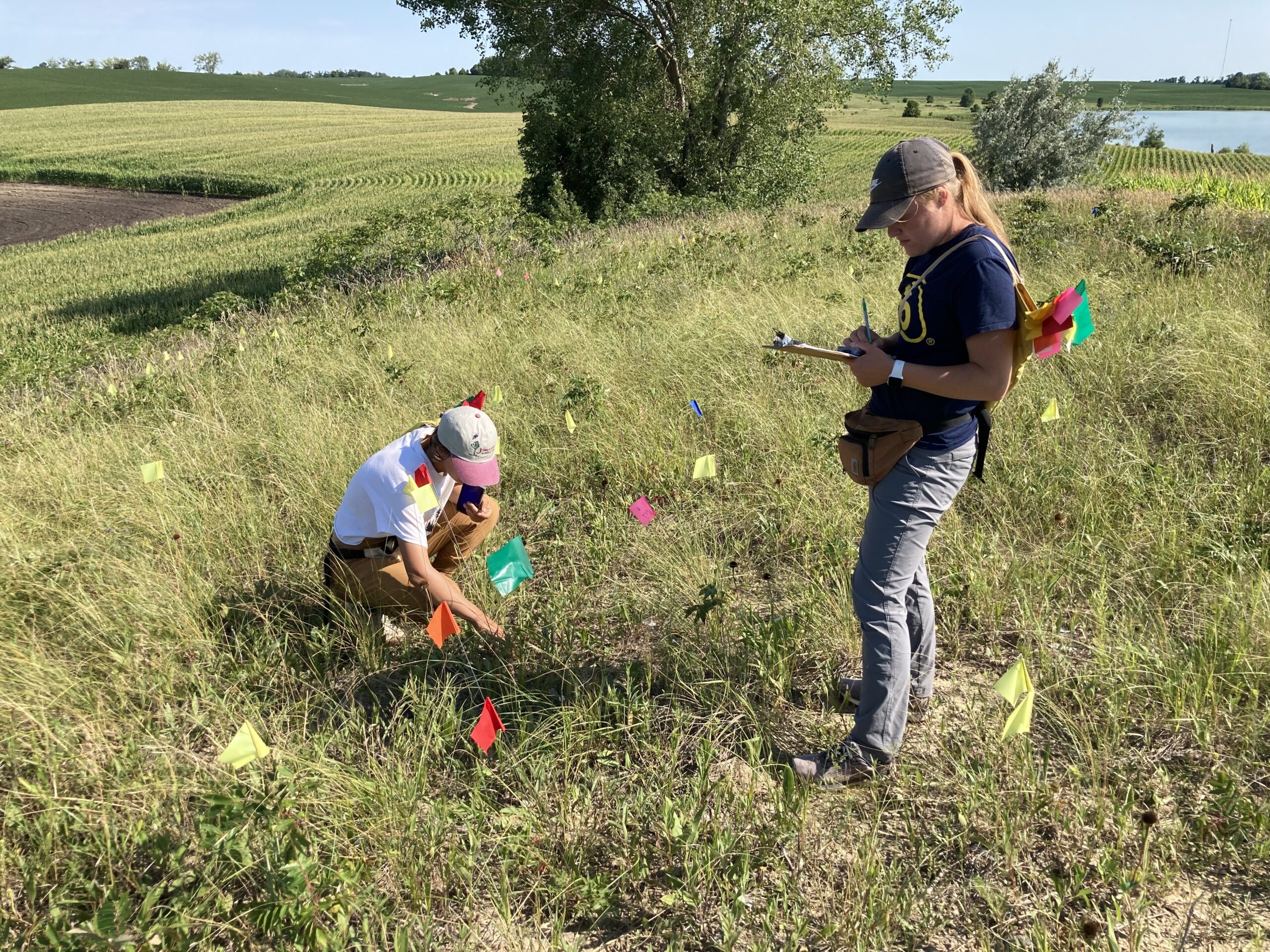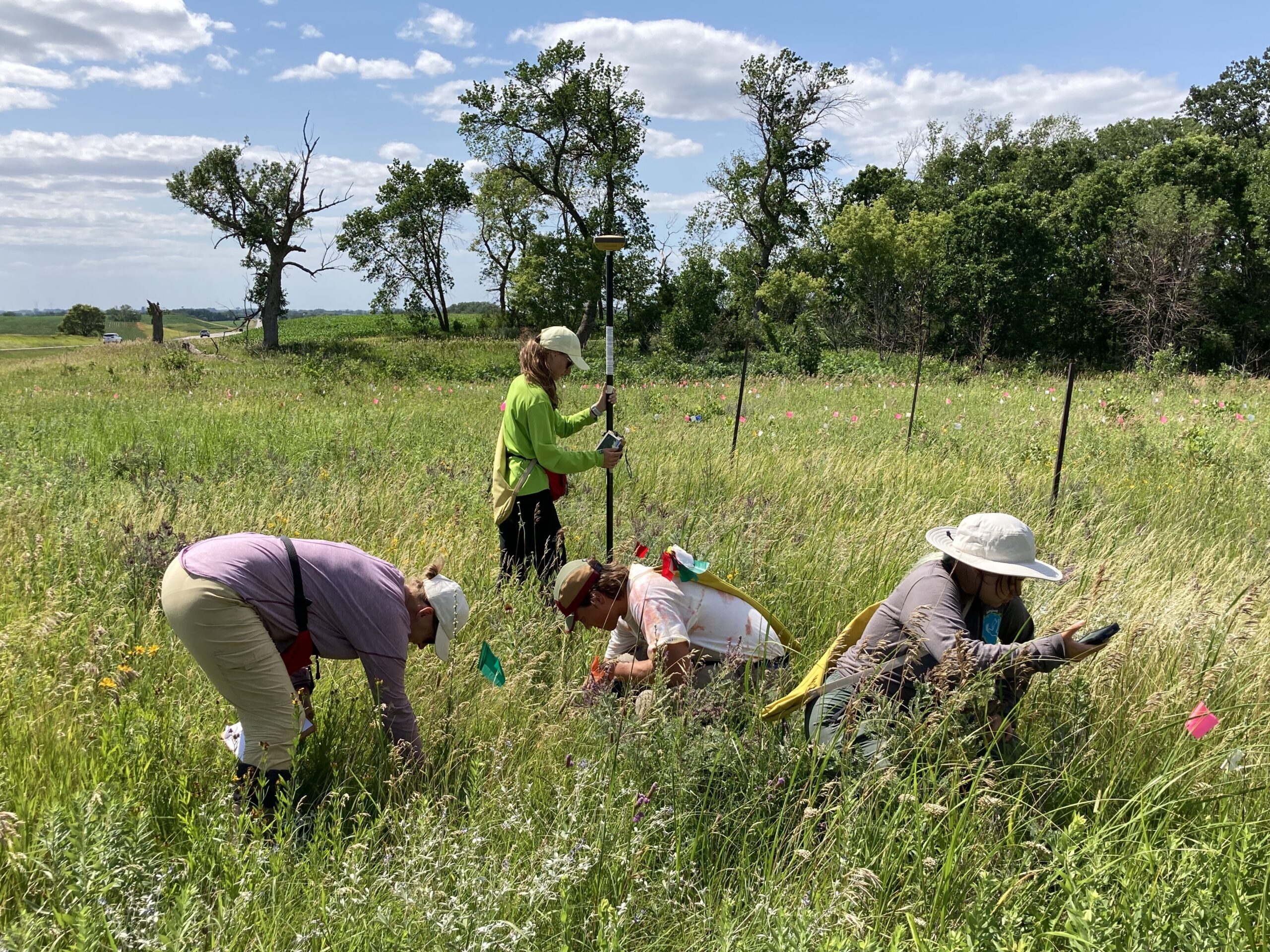Since 1995, the Echinacea Project has been mapping and collecting demographic information on Echinacea angustifolia to generate detailed, long-term records of individual fitness in prairie remnants. In summer 2022, Team Echinacea visited 34 prairie remnants to search at 2927 locations where adult Echinacea plants had been previously mapped, a process we call “total demo.” At small sites, the team searched for all adult plants, and at large sites, we visited a subset of the adult plants. This year, we did not visit plants that had been “not present” for the past 4 years. However, we added plants that flowered for the first time in 2019, 2020, or 2021. At the large sites, we added many more plants than we removed; at Landfill, we removed 18 plants but added 129 new plants, so we visited 285 plants in total. We plan to revisit the total demo protocol before next summer so our subsets do not reach unreasonable sizes.
At each Echinacea plant, the team used handheld data collectors (visors) to record the flowering status, number of flowering heads, number of rosettes, and near neighbors of the plant. We then mapped the location of every flowering plant within each prairie remnant using a high-precision GPS unit. Unfortunately, the new GPS unit, Collins, stopped working early in the summer. Nevertheless, the team persisted with the old GPS.
In summer 2022, Team Echinacea collected 7926 demographic records (demo) and recorded 3708 GPS points (surv). In total, we collected data on ~2870 flowering Echinacea angustifolia plants. A combination of favorable weather and prescribed burns made it a record-breaking year for flowering Echinacea. Landfill had 713 flowering plants this year (east: 373, west: 340) compared to only 327 last year. There were 518 flowering plants at Loeffler’s Corner (east: 292, west: 226), and 266 flowering plants at Staffanson. The demo and surv datasets are in the process of being combined with previous years’ records of flowering plants in “demap,” the spatial dataset of remnant reproductive fitness that the Echinacea Project maintains.
This year, new tags ranged from 27001 to 27999. However, due to the high number of flowering plants and issues with people adding unnecessary tags, we ran out of tag numbers in the 27000s. Therefore, we also used new tags ranging from 25651 to 25890 and from 26881 to 26999 in 2022.
We are especially interested in understanding how fire influences reproductive effort in fragmented prairies. The following sites were burned in spring 2022: Bill Thom’s Gate, Landfill West, Loeffler’s Corner West, Martinson’s Approach, Northwest of Landfill, North of Northwest Landfill, Staffanson West, and West of Aanenson. We noticed increases in flowering at most burned sites, even some of the small ones. For example, West of Aanenson had 7 flowering plants this year, which is the highest flowering rate on record since we started mapping Echinacea there in 1999. Stay tuned for more results from this intriguing dataset!
- Start year: 1995
- Location: Remnant prairie populations of the purple coneflower, Echinacea angustifolia, in Douglas County, MN. Sites are located between roadsides and fields, in railroad margins, on private land, and in protected natural areas.
- Total demo: Bill Thom’s Gate, Common Garden, Dog, East of Town Hall, Golf Course, Martinson’s Approach, Near Pallida, Nessman, North of Golf Course, Randt, South of Golf Course, Sign, Town Hall, Tower, Transplant Plot, West of Aanenson, Woody’s, Yellow Orchid Hill, plus the recruitment plots REL, RHE, RHP, RHS, RHX, RKE, RKW
- Annual sample: Aanenson, Around Landfill, East Elk Lake Road, East Riley, KJ’s, Krusemarks, Loeffler’s Corner, Landfill, North of Railroad Crossing, Northwest of Landfill and North of Northwest of Landfill (lumped), On 27, Riley, Railroad Crossing, Steven’s Approach, Staffanson Prairie
- Overlaps with: Flowering phenology in remnants, reproductive fitness in remnants, EA fire and fitness, fire and flowering at SPP
- Data collected:
- Plant status (can’t find, basal, dead this year’s leaves, dead last year’s leaves, flowering), number of rosettes, nearest neighbors, and head count, if flowering
- All GPS files are found here: Dropbox/geospatialDataBackup2022
- All demo and surv records are stored in the aiisummer2022 repo
- The most recent copies of allDemoDemo.RData and allSurv.RData can be accessed at Dropbox/demapSupplements/demapInputFiles
- Samples or specimens collected: NA
- Products:
- Amy Dykstra’s dissertation included matrix projection modeling using demographic data
- The “demap” project is a long-term dataset that combines phenological, spatial and demographic data for remnant plants
You can read more about the demographic census in the remnants, as well as links to prior flog entries about this experiment, on the background page for this experiment.



Leave a Reply